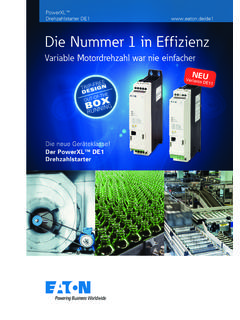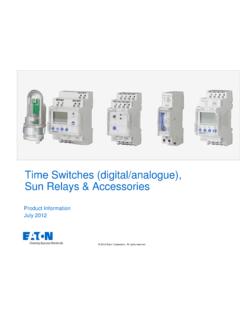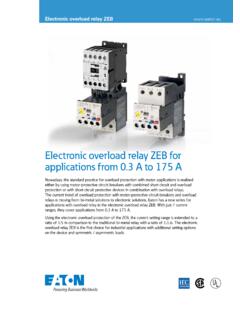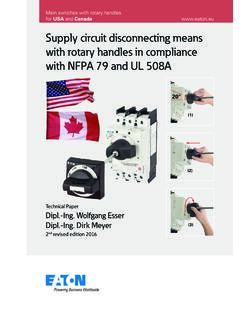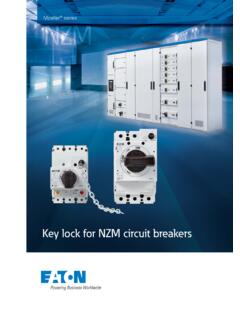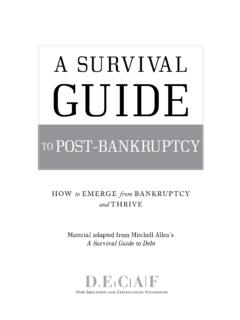Transcription of WP DC Availability v1 - Eaton
1 UPS Basics Everything you ever wanted to know about uninterruptible power systems but were afraid to ask. By Chris Loeffler, Product Manager, BladeUPS and Data Center Solutions, Distributed Power Quality, and Ed Spears, Product Manager, Eaton Power Quality Solutions Operation Eaton Corporation Executive summary Budgeting for electricity, securing adequate supplies of it and finding ways to use less of it are all common topics of conversation among data center operators. Ensuring that the power their IT resources rely on is both dependable and clean, sadly, can sometimes be an afterthought. In truth, however, power sags, surges and outages are not only unavoidable but more than capable of damaging valuable IT equipment and bringing productivity to a halt. That s why planning and deploying a robust power protection solution is absolutely vital.
2 An uninterruptible power system (UPS) is the central component of any well-designed power protection architecture. This white paper provides an introductory overview of what a UPS is and what kinds of UPS are available, as well as a comprehensive guide to selecting the right UPS and accessories for your needs. Table of contents Why is power protection important? .. 2 What is a UPS? .. 2 What are the main types of UPS? .. 2 Single-conversion systems .. 2 Double-conversion systems .. 3 Multi-mode systems .. 4 How do I choose the right UPS for the job? .. 4 Topology .. 5 Single phase versus three phase .. 5 Rating .. 5 Form factor .. 6 Availability features .. 6 Scalability and modularity .. 10 Software and communications .. 10 Services .. 12 What UPS accessories do I need? .. 12 UPS energy storage .. 12 Generator .. 13 Power distribution units .. 13 Conclusion.
3 13 About Eaton .. 13 About the authors .. 14 WP153005EN October 2011 Page 2 of 14 Why is power protection important? No company can afford to leave its IT assets unprotected from power issues. Here are just a few of the reasons why: Even short outages can be trouble. Losing power for as little as a quarter second can trigger events that may keep IT equipment unavailable for anywhere from 15 minutes to many hours. And downtime is costly. Some experts believe the economy loses between $200 billion and $570 billion a year due to power outages and other disturbances. Utility power isn't clean. By law, electrical power can vary widely enough to cause significant problems for IT equipment. According to current standards, for example, voltage can legally vary from percent to percent under absolute specifications. That means that what utility services promising 208-phase voltage actually deliver can range from 191 to 220 volts.
4 Utility power isn't 100 percent reliable. In the , in fact, it's only percent reliable, which translates into a likely nine hours of utility outages every year. The problems and risks are intensifying. Today s storage systems, servers and network devices use components so miniaturized that they falter and fail under power conditions earlier-generation equipment easily withstood. Generators and surge suppressors aren t enough. Generators can keep systems operational during a utility outage, but they take time to startup and provide no protection from power spikes and other electrical disturbances. Surge suppressors help with power spikes but not with issues like power loss, under-voltage and brownout conditions. Availability is everything these days. Once, IT played a supporting role in the enterprise. These days it s absolutely central to how most companies compete and win.
5 When IT systems are down, core business processes quickly come to a standstill. Availability is everything, but power costs must be managed. The cost of power and cooling has spiraled out of control in recent years. Data center managers are typically held responsible for achieving high Availability while simultaneously reducing power costs. Highly-efficient UPS systems can help with this goal, and products are available today that were not an option even a few years ago. What is a UPS? Put simply, a UPS is a device that: 1. Provides backup power when utility power fails, either long enough for critical equipment to shut down gracefully so that no data is lost, or long enough to keep required loads operational until a generator comes online. 2. Conditions incoming power so that all-too-common sags and surges don t damage sensitive electronic gear. What are the main types of UPS?
6 UPSs come in three major varieties, which are also known as topologies: Single-conversion systems In normal operation, these feed incoming utility AC power to IT equipment. If the AC input supply falls out of predefined limits, the UPS utilizes its inverter to draw current from the battery, and also disconnects the AC input supply to prevent backfeed from the inverter to the utility. The UPS stays on battery power until the AC input returns to normal tolerances or the battery runs out of power, whichever happens first. Two of the most popular single-conversion designs are standby and line-interactive: WP153005EN October 2011 Page 3 of 14 Standby UPSs allow IT equipment to run off utility power until the UPS detects a problem, at which point it switches to battery power. Some standby UPS designs incorporate transformers or other devices to provide limited power conditioning as well.
7 Line-interactive UPSs regulate input utility voltage up or down as necessary before allowing it to pass through to protected equipment. However, like standby UPSs, they use their battery to guard against frequency abnormalities. Figure 1. Internal design of a line-interactive UPS. Double-conversion systems As the name suggests, these devices convert power twice. First, an input rectifier converts AC power into DC and feeds it to an output inverter. The output inverter then processes the power back to AC before sending it on to IT equipment. This double-conversion process isolates critical loads from raw utility power completely, ensuring that IT equipment receives only clean, reliable electricity. In normal operation, a double-conversion UPS continually processes power twice. If the AC input supply falls out of predefined limits, however, the input rectifier shuts off and the output inverter begins drawing power from the battery instead.
8 The UPS continues to utilize battery power until the AC input returns to normal tolerances or the battery runs out of power, whichever occurs sooner. In case of a severe overload of the inverter, or a failure of the rectifier or inverter, the static switch bypass path is turned on quickly, to support the output loads. Rectifier/ChargerInverterDC LinkAC SOURCEAC OutputBatteryNormal power flowStored energy power flowStatic SwitchRecharge energy flowEmergency bypass power Figure 2. Internal design of a double-conversion UPS. WP153005EN October 2011 Page 4 of 14 Multi-mode systems These combine features of both single- and double-conversion technologies while providing substantial improvements in both efficiency and reliability: Under normal conditions, the system operates in line-interactive mode, saving energy and money while also keeping voltage within safe tolerances and resolving common anomalies found in utility power.
9 If AC input power falls outside of preset tolerances for line-interactive mode, the system automatically switches to double-conversion mode, completely isolating IT equipment from the incoming AC source. If AC input power falls outside the tolerances of the double-conversion rectifier, or goes out altogether, the UPS uses the battery to keep supported loads up and running. When the generator comes online, the UPS switches to double-conversion mode until input power stabilizes. Then it transitions back to high-efficiency line-interactive mode. Multi-mode UPSs are designed to dynamically strike an ideal balance between efficiency and protection. Under normal conditions, they provide maximum efficiency. When problems occur, however, they automatically sacrifice some efficiency to deliver maximum levels of protection. The end result is that data centers can save tens of thousands a year on energy without compromising data center performance or reliability.
10 For more information on multi-mode UPSs, please see two additional white papers, Which UPS is Right for the Job and Maximizing UPS Availability at Figure 3. Internal design of a multi-mode UPS. How do I choose the right UPS for the job? To ensure that you always end up with the right UPS for your needs, be sure to consider these eight issues during your selection process: WP153005EN October 2011 Page 5 of 14 Topology Question number one is should you get a single-conversion, double-conversion or multi-mode UPS? The answer depends largely on how important energy efficiency is for your organization relative to protection. Single-conversion UPSs are more efficient than double-conversion devices, but offer less protection. That makes them a good fit for loads with a higher tolerance for failure. More specifically, standby UPSs (the most basic type of single conversion UPS) are generally the best option for smaller applications, like desktop and point-of-sale solutions, while line-interactive UPSs are typically preferable for smaller server, storage and network applications located in facilities with access to relatively trouble-free AC utility power.


